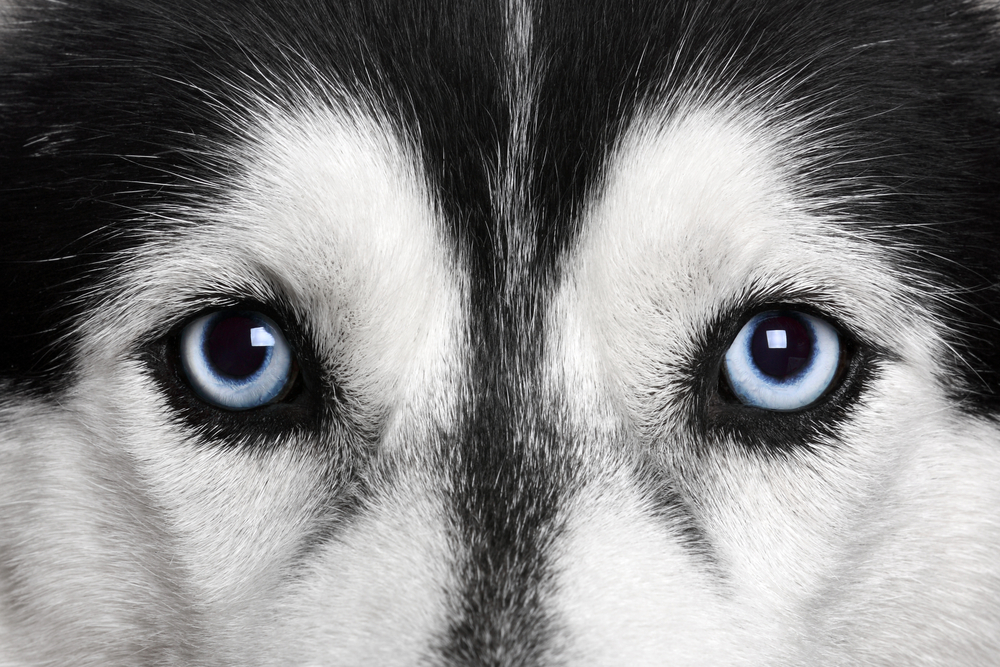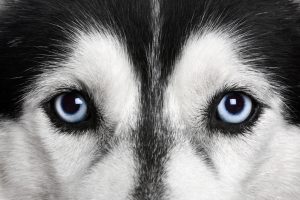Your dog’s senses are keen enough to know when you’re enjoying a tasty snack in another room or when their arch nemesis, the neighbourhood cat, is somewhere outside the house. But how much are they relying on sight to pick up on the world around them? Is the old adage “dogs see through their nose” really accurate? And when your pupper’s tail starts to wag at the sight of their favourite Dog Walker, how much of that is attributed to their actual vision?
In this article, we’re going to take a look (sorry, we couldn’t resist!) at a few facts about dog eyesight so that you know exactly how your doggo sees the world!
Fact #1: Dogs aren’t colour blind
The old idea that dogs see the world in black and white has been thoroughly debunked by modern science. We now know that our puppers are considered to be deuteranopia, meaning that they see the world with yellow and blue cones. As such, doggos can’t differentiate red and green, which might be why your pup can’t always find their tennis ball in a grassy field.
To learn more about how dogs see colour, and how you can test it out for yourself, take a look at our article, Are Dogs Colour Blind?
Fact #2: Dog eyesight is perfectly adapted for a crepuscular lifestyle
Being able to see in colour has a lot to do with whether an animal is more of an early bird or night owl. That’s because the cones responsible for seeing colour are light-dependent; they don’t work well in the dark. But dogs make up for their lack of cones with something much more useful for their lifestyle: light-detecting rods. With a higher density of these types of receptors, canines are able to hunt at dawn and dusk.
Of course, doggos have gladly given up their crepuscular lifestyle in favour of their beloved Owner’s routine. But they still have pretty good night vision! While you might find yourself stumbling around in the dark when the power goes out, your doggo will be happy to lead the way.
Fact #3: Dogs may be able to see ultraviolet
While still not well understood, some scientists have theorised that dogs are able to see ultraviolet light. Unlike humans, who have a visual shield against seeing UV light, this type of wavelength may be more easily absorbed and processed by canines.
The really fascinating part is why. One theory is that dogs use UV light to detect urine trails and other territorial markers. What might look like a boring old tree stump to you is like a Jackson Pollock to your dog. They can’t wait to take a closer look at what other doggy artists have contributed! Other theories posit that UV detection can help canines hunt in landscapes where prey animals blend into the background.
Fact #4: Dog eyesight comes with an impressive field of vision
As a Dog Owner, you’ve had plenty of practice keeping an eye on your naughty dog with your peripheral vision. But as it turns out, dogs have an even wider field of sight than we do!
Humans are able to see about 180 degrees when we use both of our eyes, but dogs can see up to 250 degrees. True, it’s not as wide a field of vision as a prey animal like a deer, but it’s perfect for a hunting canine to keep an eye on their next meal without losing sight of their fellow pack members.
Fact #5: Most dogs are better at seeing an object’s movement than its details
As we’ve established, dogs can see well in the dark and they’ve got a wide field of vision. But, when it comes to seeing objects clearly from afar, they’re not quite so good. In fact, studies of dog vision show that humans have a visual acuity (i.e. ability to see objects with clarity from a distance) that is about three times as good as dogs, both in the light of day and in dim settings. That means that, standing side-by-side, humans can detect details of objects that are much farther away than our furry companions. As long as the wind is working in your favour, then, you might be able to know what’s on the horizon before your pup.
That said, dogs are better at detecting motion from afar than specific details. Maybe they don’t know what exactly is rustling the bushes in the distance, but they’d appreciate it if you could keep up with them as they run full-speed towards it to get a better look!
It’s possible that this visual trade off of being able to see movement better than detail is related to the canine’s hunting history. After all, a wolf pack covering large expanses needs to be able to see a herd of elk or bison far off in the distance. Once they’ve located their prey on the horizon and made their approach, their other senses can get to work during the actual hunt.
Fact #6: Not all breeds see the world the same way
Every doggo in existence has been bred for a specific purpose. Some breeds were developed as friendly companions, others to sniff out rodents in the dark. And the sighthounds, well, you can guess that they were bred for amazing sight.
Sighthounds like the Greyhound and the Saluki have one huge advantage over their domestic doggo relatives: a visual streak. Their elongated muzzle and narrow skull allow them to enjoy a wider field of vision than most other dog breeds. This unique shape works to spread out the ganglion cells, a type of neuron that collects visual information, horizontally over the eye. With those super seeing cells spread out, the sighthound has a much easier time detecting motion in their periphery; a crucial ability when hunting rabbits and other agile prey in the desert.
So, how about the doggos who are more squished than sleek? As you can probably guess, brachycephalic dogs like Boxers, have a narrower field of vision, as their ganglion cells are more tightly packed.
Fact #7: The phrase “right under your nose” means something different for dogs!
We’ve all experienced that “a-ha!” moment when we realise that what we were looking for has been right under our nose the whole time. But when it comes to our doggos, they are quite literally blind to the objects right under their nose!
Thanks to that big old snoot, dogs are unable to see items that are directly under their muzzle. Not to worry though, with sensitive whiskers and an amazing sense of smell, your dog doesn’t have to look closely at the objects under their nose to know what they are.
Fact #8: You already knew this, but dog eyesight is one of your canine’s least effective senses!
At the end of this article, you might walk away with the impression that your pupper’s eyesight is, well, not what you might expect for a powerful predator. But the reality is, dogs don’t need good eyesight to be amazing hunters, herders, guardians, retrievers, and more! With an unbelievable sense of smell and hearing, dogs can detect much more of the world around them than we could ever imagine. And it’s these other senses that have made them so indispensable for us humans, while also sometimes leading them to do naughty things like dig through the rubbish and chew on our socks.
So, next time that your pupper seems to lose the toy that’s right under their nose or fail to recognise their favourite Dog Walker until the last possible moment, just remember that dog eyesight is just the beginning of your dog’s incredible abilities!


